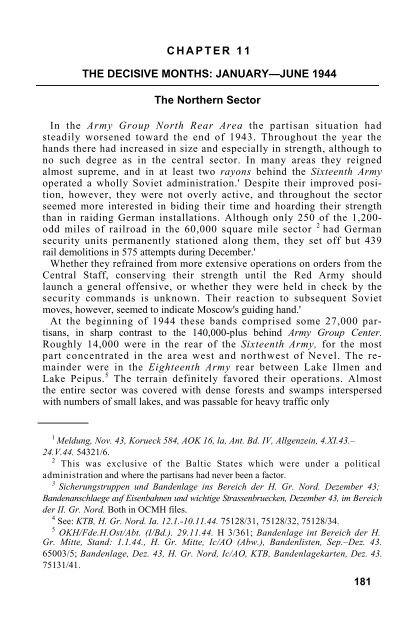the soviet partisan movement 1941-1944 by edgar m. howell
the soviet partisan movement 1941-1944 by edgar m. howell
the soviet partisan movement 1941-1944 by edgar m. howell
Create successful ePaper yourself
Turn your PDF publications into a flip-book with our unique Google optimized e-Paper software.
THE DECISIVE MONTHS: JANUARY—JUNE <strong>1944</strong> <br />
CHAPTER 11<br />
<br />
The Nor<strong>the</strong>rn Sector<br />
In <strong>the</strong> Army Group North Rear Area <strong>the</strong> <strong>partisan</strong> situation had<br />
steadily worsened toward <strong>the</strong> end of 1943. Throughout <strong>the</strong> year <strong>the</strong><br />
hands <strong>the</strong>re had increased in size and especially in strength, although to<br />
no such degree as in <strong>the</strong> central sector. In many areas <strong>the</strong>y reigned<br />
almost supreme, and in at least two rayons behind <strong>the</strong> Sixteenth Army<br />
operated a wholly Soviet administration.' Despite <strong>the</strong>ir improved position,<br />
however, <strong>the</strong>y were not overly active, and throughout <strong>the</strong> sector<br />
seemed more interested in biding <strong>the</strong>ir time and hoarding <strong>the</strong>ir strength<br />
than in raiding German installations. Although only 250 of <strong>the</strong> 1,200<br />
odd miles of railroad in <strong>the</strong> 60,000 square mile sector 2 had German<br />
security units permanently stationed along <strong>the</strong>m, <strong>the</strong>y set off but 439<br />
rail demolitions in 575 attempts during December.'<br />
Whe<strong>the</strong>r <strong>the</strong>y refrained from more extensive operations on orders from <strong>the</strong><br />
Central Staff, conserving <strong>the</strong>ir strength until <strong>the</strong> Red Army should<br />
launch a general offensive, or whe<strong>the</strong>r <strong>the</strong>y were held in check <strong>by</strong> <strong>the</strong><br />
security commands is unknown. Their reaction to subsequent Soviet<br />
moves, however, seemed to indicate Moscow's guiding hand.'<br />
At <strong>the</strong> beginning of <strong>1944</strong> <strong>the</strong>se bands comprised some 27,000 <strong>partisan</strong>s,<br />
in sharp contrast to <strong>the</strong> 140,000-plus behind Army Group Center.<br />
Roughly 14,000 were in <strong>the</strong> rear of <strong>the</strong> Sixteenth Army, for <strong>the</strong> most<br />
part concentrated in <strong>the</strong> area west and northwest of Nevel. The remainder<br />
were in <strong>the</strong> Eighteenth Army rear between Lake Ilmen and<br />
Lake Peipus. 5 The terrain definitely favored <strong>the</strong>ir operations. Almost<br />
<strong>the</strong> entire sector was covered with dense forests and swamps interspersed<br />
with numbers of small lakes, and was passable for heavy traffic only<br />
1<br />
Meldung, Nov. 43, Korueck 584, AOK 16, la, Ant. Bd. IV, Allgenzein, 4.XI.43.–<br />
24.V.44. 54321/6.<br />
2<br />
This was exclusive of <strong>the</strong> Baltic States which were under a political<br />
administration and where <strong>the</strong> <strong>partisan</strong>s had never been a factor.<br />
3<br />
Sicherungstruppen und Bandenlage ins Bereich der H. Gr. Nord. Dezember 43;<br />
Bandenanschlaege auf Eisenbahnen und wichtige Strassenbruecken, Dezember 43, im Bereich<br />
der II. Gr. Nord. Both in OCMH files.<br />
4<br />
See: KTB, H. Gr. Nord. Ia. 12.1.-10.11.44. 75128/31, 75128/32, 75128/34.<br />
5<br />
OKH/Fde.H.Ost/Abt. (I/Bd.). 29.11.44. H 3/361; Bandenlage int Bereich der H.<br />
Gr. Mitte, Stand: 1.1.44., H. Gr. Mitte, Ic/AO (Abw.), Bandenlisten, Sep.–Dez. 43.<br />
65003/5; Bandenlage, Dez. 43, H. Gr. Nord, Ic/AO, KTB, Bandenlagekarten, Dez. 43.<br />
75131/41.<br />
181
















